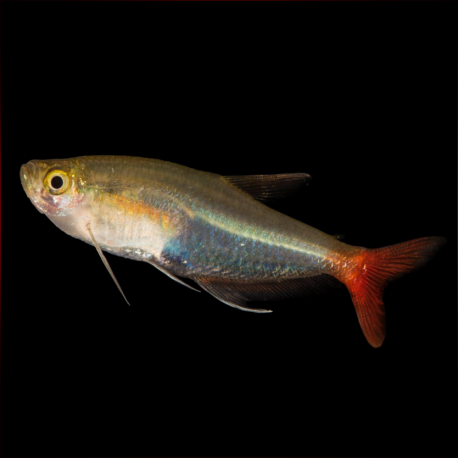More info
Datasheet
| Minimum Tank Size | 120 litres / 31.70 US gallons |
| Maximum Size | 45cm / 17.72inches |
| Temperament | Peaceful |
| Care Description | Easy |
| Temperature | 22.2°C / 71.96°F - 26.7°C / 80.06°F |
| Carbonate Hardness | 4-8 |
| pH | 6.6-7.0 |
General Description
The Filigree Bloodfin Tetra Group, also known as the Glass Bloodfin Tetra, is a species native to the clear, slow-moving waters of South America. Possessing translucent silver bodies with a mesmerizing blue iridescence along their anterior sides, these tetras sport a striking pop of blood-red coloration in their tail fins. This species brings instant wonder and subtle elegance to any tropical planted aquarium.
Aquarium Setup
For optimal care, it is recommended to house a group of six or more Filigree Bloodfin Tetras in a minimum 30-gallon aquarium. Providing plants, rocks, and driftwood within the tank offers these tetras hiding places and security. Maintaining a steady slightly acidic pH level and a constant temperature is essential for their well-being. As mid-level swimmers, taller plants are ideal for their habitat.
Behaviour
Filigree Bloodfin Tetras are known for their peaceful temperament, making them excellent community tank inhabitants. They are active swimmers, best kept in groups to promote their natural behavior and reduce stress levels. These tetras are generally friendly towards tank mates and do well in a harmonious aquarium environment.
Feeding and Diet
Considered carnivores, Filigree Bloodfin Tetras accept a varied diet. They enjoy small foods such as brine shrimp, daphnia, freeze-dried bloodworms, tubifex, micro pellet food, and high-quality flake food. Offering a diverse diet ensures their nutritional needs are met and supports their overall health and vibrancy.
Reproduction & Dimorphism
In terms of reproduction, the female Filigree Bloodfin Tetra lays a relatively small number of eggs during breeding. These eggs typically hatch within approximately 24 hours post-fertilization. To protect the fry from being consumed by adult tetras, it is advisable to use a separate breeding tank and promptly remove the adults after spawning. Males are typically smaller and slimmer, while females are larger and rounder, with some exhibiting a larger first anal fin with white beams.
Habitat and Distribution
Prionobama filigera, commonly known as the Filigree Bloodfin Tetra, originates from South America. These tetras are typically found in clear, slow-moving waters in their natural habitat. Adaptable to varying water conditions within the specified range, they thrive in environments that mimic their native South American waters.

